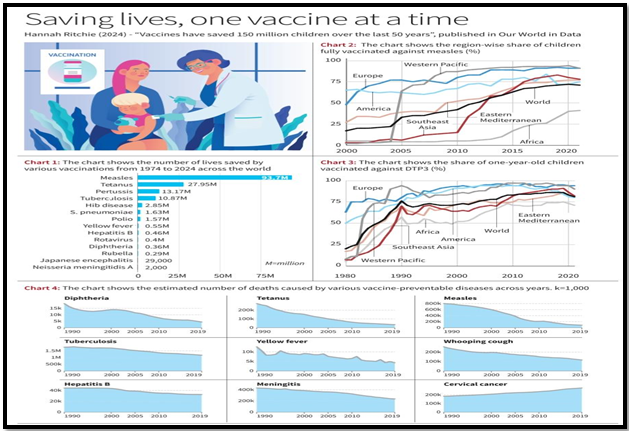THE IMPACT OF 50 YEARS OF VACCINATION ON CHILDREN WORLDWIDE
Date : 14/05/2024
Syllabus:
GS 2:
- Health
- Issues Relating to Development and Management of Social Sector/Services relating to Health
- Government Policies and Interventions for Development in various sectors
Focus:
The article highlights the significant milestone of 50 years of vaccination programs and their impact on global child health, particularly as new research published in The Lancet underscores the life-saving benefits of vaccines and the continued need for global immunization efforts to prevent vaccine-preventable diseases.
Source: TH
About Measles
Treatment:
|
Measles Vaccination: A Lifesaver
- Over the past five decades, vaccinations have saved the lives of approximately 150 million children globally.
- Measles vaccination alone accounts for 60% of these lives saved, benefiting 94 million individuals.
- The measles vaccination rate saw a significant increase, from less than 20% in 2000 to 70% by 2021 worldwide.
- Similarly, there has been a notable rise in vaccinations against diphtheria, pertussis, and tetanus (DTP3).
- These vaccination efforts have substantially reduced infant mortality rates from around 10% in 1974 to 3% in 2024, with vaccines contributing to 40% of this decline.
Global Immunisation Programmes
- The expansion of immunisation programmes globally has played a crucial role in reducing deaths from vaccine-preventable diseases.
- In 1974, the World Health Assembly initiated the Essential Programme on Immunization, aiming to eradicate vaccine-preventable diseases.
- Vaccination coverage outside of Europe and North America was almost negligible 50 years ago, with less than 5% of infants receiving the DTP3 vaccine.
- By 2021, over 80% of infants worldwide received the third dose of the DTP3 vaccine.
- The introduction of various vaccination programmes has led to a significant rise in vaccination rates, particularly in regions that were previously under-vaccinated.
Regional Progress in Vaccination Coverage
- The Western Pacific region experienced a remarkable increase in measles vaccination coverage, from 22% in 2000 to 91% in 2021.
- Southeast Asia also showed significant progress, with measles vaccination rates rising from 15% in 2010 to nearly 80% in 2021.
- The Western Pacific region’s DTP3 vaccination rate improved drastically, from less than 10% in 1980 to 90% in 2021.
- Despite initial low coverage, regions outside of Europe and North America have shown substantial improvement in vaccination rates.
- Coordinated efforts by global health organizations have been instrumental in achieving these advancements.
Challenges and Solutions
- Despite significant progress, millions of children, particularly in Africa and Asia, remain under-vaccinated.
- By 2000, progress in vaccination coverage was stalling, leaving many of the world’s poorest infants behind.
- The formation of Gavi, the Vaccine Alliance, aimed to close these gaps by ensuring that vaccination programmes are available for all.
- Gavi is a partnership between the Bill and Melinda Gates Foundation, WHO, UNICEF, and the World Bank.
- While Gavi has helped improve global vaccination rates, gaps still exist, and insufficient vaccination coverage continues to cause millions of preventable deaths each year.
The Continued Fight Against Vaccine-Preventable Diseases
- Tuberculosis remains a major threat, claiming over a million lives annually.
- Measles, tetanus, whooping cough, meningitis, and hepatitis B still cause hundreds of thousands of deaths each year.
- Chart 4 illustrates the estimated number of deaths caused by various vaccine-preventable diseases over the years.
- Achieving universal vaccine coverage is essential to prevent these deaths, requiring increased investment and coordination from governments.
- It is also crucial to address vaccine scepticism and fear to achieve universal coverage.
The Role of Gavi, the Vaccine Alliance
- Established in 2000, Gavi has played a critical role in improving vaccination coverage worldwide.
- Gavi is a partnership between the Bill and Melinda Gates Foundation, WHO, UNICEF, and the World Bank.
- Gavi has focused on providing vaccines to the world’s poorest countries, significantly improving immunisation rates.
- The alliance has been instrumental in closing vaccination gaps and ensuring more equitable access to vaccines.
- Continued support and collaboration with global health organizations are necessary to maintain and expand vaccination efforts.
The Path Forward
- To achieve universal vaccine coverage, governments must increase investment and coordination in immunisation programmes.
- Public health initiatives should focus on education and addressing vaccine scepticism and fear.
- International cooperation and support from global health organizations will be crucial in achieving vaccination goals.
- Efforts must be made to reach the most vulnerable populations, particularly in low-income countries.
- Ongoing research and development of vaccines are essential to combat emerging diseases and improve existing immunisation programmes.
Conclusion:
Continued efforts and investments are necessary to achieve universal vaccination coverage and ensure that all children, regardless of location, have access to life-saving vaccines. Global cooperation and a focus on education and addressing vaccine hesitancy will be crucial in this ongoing battle to protect future generations.
Source:The Hindu
Mains Practice Question:
Discuss the impact of global vaccination programs on child mortality rates over the past 50 years. Highlight the role of international organizations in enhancing vaccination coverage and the challenges that still need to be addressed to achieve universal immunization.
Associated Article:
https://universalinstitutions.com/is-india-lagging-in-measles-vaccination/




